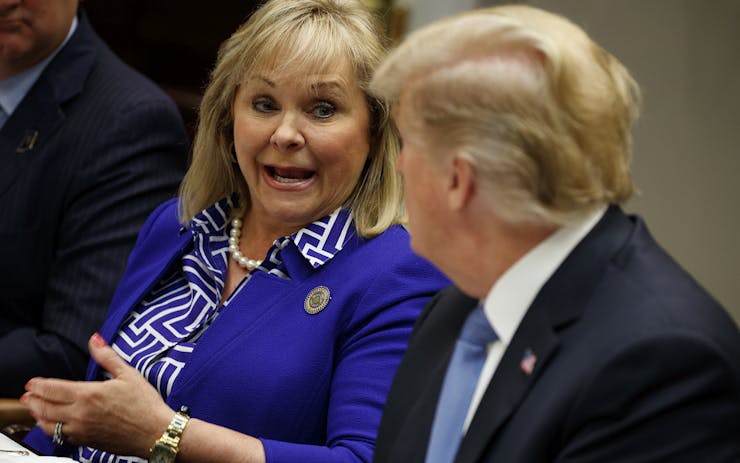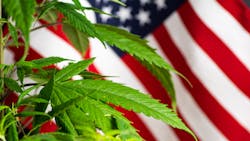Just weeks after Oklahoma voters roundly approved a permissive medical marijuana legalization measure, Gov. Mary Fallin on Wednesday signed into place strict emergency rules that cannabis advocates say are intentionally aimed at delaying the new law.
The new rules include last-minute changes to ban the sale of smokable cannabis, limit the potency of products such as concentrates, and require a pharmacist at every medical cannabis dispensary. Fallin, the state’s term-limited Republican governor, signed the rules just one day after her appointees on the state’s Board of Health adopted them at an emergency meeting.
“It's a slap in the face to all activists. It's a slap in the face to all Oklahomans who voted on 788.”
Those late additions to the rules infuriated longtime medical marijuana advocates who helped get the measure on the ballot last month, when nearly 57% of Oklahoma voters approved it . Her quick signature also came just as medical cannabis advocates were rallying supporters to urge her to reject them.
“People are completely angry. They voted for [State Question] 788, and now you have the health department and our governor pull these shenanigans?” said Isaac Caviness, president of Green the Vote, a marijuana advocacy group that pushed for the passage of the state question. “It’s a slap in the face to all activists. It’s a slap in the face to all Oklahomans who voted on 788.”
The new rules on potency are likely to create headaches for many medical marijuana patients, who often require specific products to address certain medical conditions. The emergency rules state that “Medical marijuana products and Medical Marijuana Concentrate processed or dispensed shall have a THC content of not more than twelve percent (12%). Mature plants marijuana [sic] shall have a THC content of not more than twenty percent (20%).”
Most cannabis flower contains between 12% and 30% THC, while cannabis concentrates regularly exceed 50% THC and can sometimes contain more than 95% THC.
Groups that opposed legalization, including ones that represent doctors, pharmacists, hospitals and chambers of commerce, called earlier this week for new restrictions on the industry, including a ban on the sale of smokable flower and the requirement to have a pharmacist on site.
The board approved the two provisions against the advice of the health department’s general counsel, who said the rules likely were beyond the agency’s legal authority. Marijuana advocates say they’re considering legal action against the board.
The rule restricting the sale of smokable flower reportedly won’t affect the law’s provision allowing medical marijuana patients to grow their own cannabis.
Shop highly rated dispensaries near you
Showing you dispensaries nearIn a statement on Wednesday, Fallin said she thinks the rules were the best way to quickly set up a regulatory framework for medical marijuana.
“I know some citizens are not pleased with these actions,” Fallin said. “But I encourage everyone to approach this effort in a constructive fashion in order to honor the will of the citizens of Oklahoma who want a balanced and responsible medical marijuana law.”
The changes rankled medical marijuana proponents who accused the board of defying the will of the people.
“The people were clear. They wanted to be able to smoke medical marijuana,” former state Sen. Connie Johnson, a longtime advocate for legalized marijuana, said earlier this week. “This flies in the face of what the people wanted.”
Legal wrangling has gummed up the rollout of medical marijuana in several other states, including in neighboring Arkansas, where a proposal approved by voters in 2016 remains on hold because of a legal challenge. There were years of court fights in Michigan after voters there approved medical marijuana in 2008. Only now, ten years later, is Michigan on the verge of issuing its first state-approved medical cannabis licenses.
“This is an attempt to kneecap the program, not a good-faith effort to implement it safely.”
In Oklahoma’s June 26 primary election, nearly 57% of voters said yes to one of the least-restrictive medical marijuana laws in the country. The approved initiative makes it legal to grow, sell, and use marijuana for medicinal purposes. The law, which made it to the ballot through signature petition, outlines no qualifying conditions—allowing physicians to authorize its use for a broad range of ailments—and gives the state 60 days to implement.
Health board member Charles Skilling, the CEO of a hospital in Shawnee and the member who proposed the ban on smokable flower, said he did it out of concern for public health. Health advocates have pushed for so long against smoking cigarettes that it was hard for them to endorse smoking of any kind.
A similar argument was made by Florida regulators when they outlawed smokable flower after voters in that state approved a medical marijuana measure in 2016. The ban was eventually overturned earlier this year after it was successfully challenged in court by John Morgan, a lawyer who helped pass Florida’s legalization law.
Oklahoma’s interim commissioner of health said the agency is fully prepared to move forward with a regulatory framework for the new industry in the state, although he acknowledged legal challenges are likely.
“I have no reason to think it won’t go smoothly and that the will of the people won’t be adhered to,” said Commissioner Tom Bates.
Chip Paul, who helped write Oklahoma’s medical marijuana state question and push for its approval, said the board’s last-minute changes were problematic, but he’s optimistic the state is closer to helping patients.
“Even with a pharmacist on site, even with no smokable marijuana, we now have a program where patients who are suffering can at least get some relief, and that’s a giant, huge deal,” Paul said.
Bud Scott, an attorney who represents several marijuana businesses, called the board’s actions “an insult to our democratic institutions.”
“This is an attempt to kneecap the program,” Scott said, “not a good-faith effort to implement it safely.”
Scott has called for a special legislative session for lawmakers to set up a regulatory framework, and Fallin initially supported the idea. But the governor reversed course when lawmakers expressed little appetite to return to the Capitol to tinker with the new law just ahead of the November election.
Meanwhile, marijuana advocates are gathering signatures for a statewide vote on whether to fully legalize cannabis for recreational use in Oklahoma. Organizers say they’ve gathered about 84,000 signatures so far and need about 40,000 more by Aug. 8 to qualify for the November ballot.
Oklahoma’s was the first marijuana question on a state ballot in 2018, with elections scheduled for later this year in Michigan and Utah.
The Associated Press contributed to this report, with additional reporting by Leafly Staff.





